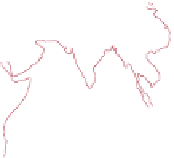Geoscience Reference
In-Depth Information
0°
60%
40%
0°
Figure 11.14
Regions experiencing a seasonal surface wind shift of at least 120°, showing the frequency
of the prevailing octant.
Source: After Khromov.
0°
60°
120°W
20°N
0°
Summer rain (max)
Double rain (max)
Winter rain (max)
Desert
20°S
Figure 11.15
The annual distribution of tropical rainfall. The shaded areas refer to periods during which more than
75 percent of the mean annual rainfall occurs. Areas with less than 250mm y
-1
(10in y
-1
) are classed as deserts, and
the unshaded areas are those needing at least seven months to accumulate 75 percent of the annual rainfall and are
thus considered to exhibit no seasonal maximum.
Source: After Ramage (1971). By permission of Academic Press.
northward in response to the distribution of solar
heating of the earth, and in South Asia this
movement is magnified by the effects of the
land mass. However, the attractive simplicity of
the traditional explanation, which envisages a
monsoonal 'sea breeze' directed towards a summer
thermal low pressure over the continent, provides
an inadequate basis for understanding the work-
ings of the system. The Asiatic monsoon regime is
a consequence of the interaction of planetary and
regional factors, both at the surface and in the
upper troposphere. It is convenient to look at each
season in turn;
Figure 11.16
shows the generalized
meridional circulation at 90
°
E over India and the






























































































































































































